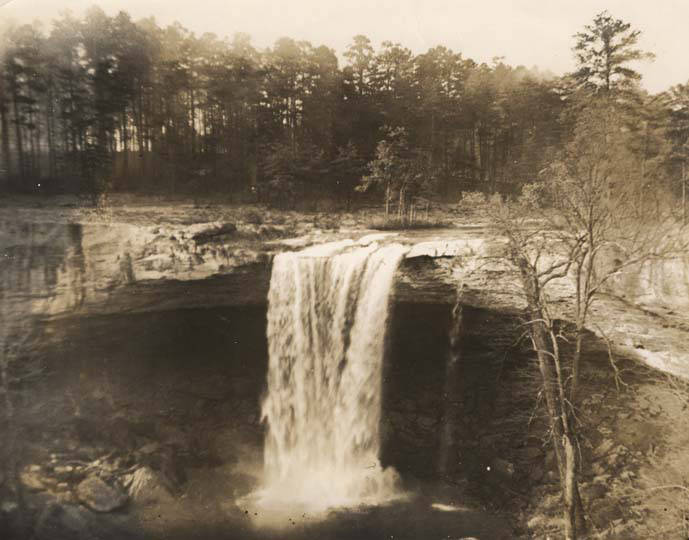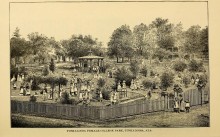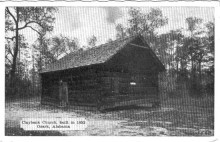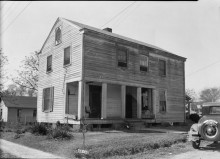Noccalula Falls near Gadsden ca. 1930s
(Continued – from Alabama Folklore Part I)
Unemployed authors were employed through the Works Project Administration WPA to record the life and culture of Americans during the Great Depression era. Many were employed in Alabama. In 1937, this excerpt was part of an essay written about Alabama Folklore. The author stated this purpose in writing the essay at the end. The essay is long so it has been divided into several parts. Since it was written in the 1930’s, it captures some of the language of the times so be forewarned that it might offend some readers.
The simple tales that have colored existence for the generations also become fewer, unless captured and put on the printed page. The line of storytellers grows thin. Widespread education, new modes of thought and life are responsible for the passing.
To preserve these legends that are so essential a part of the history of the people, the chronicler must prepare his records with haste before the sources have dried.
Become an Alabama Pioneers Patron today and share your information through chats and comments with other Alabama Pioneers Patron members.
Alabama Folklore Part II
(The excerpts below have been transcribed from an Essay titled Alabama Folklore March 26, 1937, by J. Edward Rice, Pettersen Marzoni and rewritten by David Holt, Editorial Department, Federal Writers Project Dist. 2, WPA Project 3014, Identification No. 0149-17374)
Alabama Pocahontas
A further illustration of this duplication of legend may be found in the factual and historical story of Milly, daughter of the half-breed chieftain Hillishadjo, who offered herself as a sacrifice to save a white captive of her father’s tribe. In this act, Milly paralleled the famous Pocahontas – Capt. John Smith story of the Virginia Colony. Milly, however, unlike Pocahontas, did not marry a white man, but became the wife of an Indian brave.
Chief Hillishadjo was the son of Dr. David Francis, who settled in Alabama in 1761 at the Indian town of Atagi (Autauga) about 12 miles from the present capital of Montgomery. There he married an Indian girl and Hillishadjo was his only child. The boy became the Great Prophet of the Creeks when he grew to manhood and married a daughter of the nation. His first child was a girl, Malee, known to the whites as Milly.
During the fighting between the Creeks and the whites under General Andrew Jackson, Hillishadjo and his family moved to Fowl Town on the Apalachicola River. One day Duncan McKrimon, a young Georgia militiaman stationed at Fort Gadsden, was captured by the Indians. He was sentenced to execution and tied to a tree.
Milly pleaded with her father to save his life, but he ordered the execution to proceed. Milly then three herself between the white man and his threatened slayers. Her bravery and pleadings won McKrimon his life and he was spared to be sold to the Spaniards at St. Marks, Florida. Shortly thereafter McKrimon escaped.
On the death of Hillishadjo, Milly was in want and McKrimon learned of it and offered to marry her, Milly, feeling that the offer was based on pity rather than affection refused, and later married a member of the tribe.
Seas that Mourn
Legend does not take such idyllic twists in all of Alabama’s Indian folklore. There are the 12 Indian maidens and the mourning waves of Portersville Bay, whose suicide to escape marriages without love strikes a note in harmony with European folk tales.
The tragic maiden who surrenders life to avoid an unhappy fate is more than national in scope. Alabama’s prototype is the beautiful Alavelda who threw herself into the falls of the Nocallua to escape the persistent attentions of a Cherokee Chieftain.
The imaginative today claim that the vision of the beautiful Alvelda may be seen in the still clear water below the falls, three miles from Gadsden.
Water, whether in the sea, a lake or some swift flowing stream, is the setting of many legends in all lands. A bottomless pool in Northwest Alabama, near Russellville, is supposed to mark the wrath of the gods at a council which ordered the death of two mothers.
Blue Pond, as the pool, several acres in extent, is known, is credited with having been created when a Cherokee tribe ordered the execution of the mothers and their infant sons, who had been born spotted as leopards.
Legend states that the mothers were placed on a blazing pyre and that as the flames licked round them, the earth yawned, so that pyre, victims and the entire tribe dropped into a bottomless pit. Water rushed in and Blue Pond was born.
Some Descendants of John Washington Mackey (1789-1885)
John Washington Mackey was an early pioneer of Perry County, Alabama is believed to have been the son of John G. and Mary Mackey of Buncombe County, NC. He was born Sept 21, 1822, in Alabama or NC and died Mar 19, 1888, in Jefferson County, Alabama.
Descendant surnames of John Washington Mackey include: ALEXANDER, AGNEW, ALLEN, BLACKWELL, BOYD, DENSON, EDWARD, KNOX, LACEY, RAY, SINGLY, WESTBROOK, WYATT





